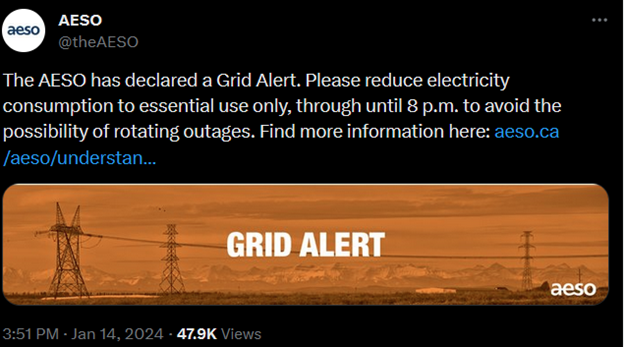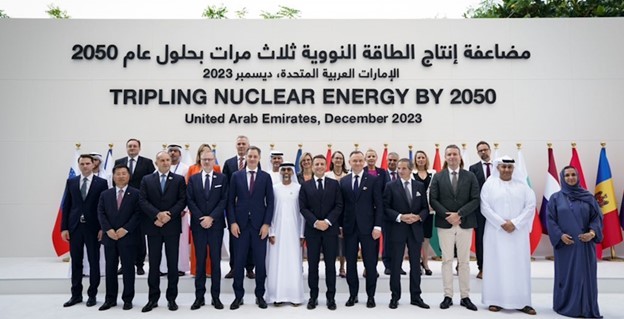Over the weekend Alberta’s electricity system operator issued a grid alert asking residents to immediately reduce electricity usage to essentials only to avoid the risk of rotating power outages. This came at a time when the province was enduring record temperatures, experiencing one of the coldest nights of the past 50 years.

The AESO revealed that the pressures on the grid were caused by the extreme cold and that at one point the system only had 10 megawatts of reserve power despite adding 2400 MW of new generation capacity last year, most of which came from renewable sources.
This event highlights the challenges associated with transitioning to a renewable energy system. Renewables introduces a lot of reliability risk when the sun isn’t shining and the wind isn’t blowing, which was the case last Saturday at 7pm.
In addition to this, the Alberta energy landscape is already faced with existing challenges such as:
- Dependence on oil and gas which make it vulnerable to fluctuations in global energy prices. Over reliance on these resources has led to economic instability during low oil prices.
- Environmental concerns with climate change driving a lot of policies right now and Alberta continuing to face criticism for high GHG emissions, particularly in the oil sands. Political pressures from the federal government coupled with mechanisms like carbon tax stifle growth in the energy sector.
- Pipeline challenges due to regulatory hurdles (ie. Impact Assessment Act) that prevent the construction and expansion of pipelines to transport Alberta’s oil and gas to international markets. Fierce opposition from environmental and Indigenous groups have constrained the industry’s ability to access new markets.
- Limited market access due to Alberta’s landlocked geography have resulted in discounted prices for its energy products impacting the province’s economic outlook.

As Alberta embarks on the journey towards more sustainable clean energy sources, SMRs offer a very promising solution to these challenges.
Here are the top 3 reasons why Alberta should embrace the power of SMRs today:
- Reduce carbon emissions – Without question, the ability to reduce carbon emissions is one of the most compelling reasons for Alberta to invest in SMRs. SMRs will be able to produce carbon free electricity to provide power for industrial applications, grid deployment and remote communities
- Energy security and reliability – With an unregulated electricity market and an energy infrastructure that relies heavily on oil and natural gas, the Alberta energy system is subject to price volatility and supply disruptions. SMRs offer a reliable and consistent source of energy which will reduce the province’s vulnerability to energy market fluctuations. This enhanced security will provide stability for Alberta’s’ growing economy and ensure a continuous supply for Albertans.
- Job creation and economic growth – SMRs will create significant economic benefit for the province in the form of job creation, infrastructure contracts and direct foreign investment. Skilled tradespeople will be needed to help design, build, operate and maintain the reactors with an opportunity to transition the existing energy labour force into the nuclear industry. Furthermore, a thriving nuclear industry in the province would provide a new revenue stream with clean energy exports and would promote research and development.
Alberta Innovates, the province’s innovation engine, is already doing a lot of the groundwork to create enabling conditions and lead the development of SMRs in Alberta. The newly formed SMR consortium aims to support the growth of an ecosystem in the province. The consortium will also help drive efforts to investigate all possible applications of SMRs in Alberta with work already underway to explore SMRs in the oil sands.

The Alberta opportunity
Alberta is an energy superpower, but its position is being challenged by external factors outside of its control. With nuclear, that can change.
SMRs hold the potential to be a gamechanger for Alberta by offering a path to energy security, reduced carbon emissions, and economic growth. COP28 revealed that the world finally recognizes the key role that nuclear power will play in climate change with 22 countries signing a declaration to triple global nuclear capacity by 2050.

And as the winds of change shift globally to embrace nuclear, so too must Alberta.
With an interprovincial MOU in place between New Brunswick, Ontario, and Saskatchewan, federal incentives, a provincial strategic plan and a nuclear supply chain that is poised and ready to go−now is the time for Alberta to seize this opportunity.
By investing in SMRs today, Alberta will chart a course to meet its climate goals, secure a clean energy future and usher in new era of prosperity powered by nuclear.